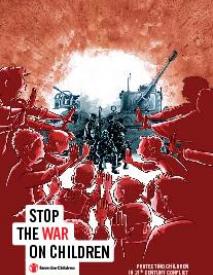Stop the War on Children : Protecting Children in 21st Century Conflict
The nature of conflict has changed, putting children in the frontline in new and terrible ways. Wars are lasting longer. They are more likely to be fought in urban areas amongst civilian populations leading to deaths and life-changing injuries, and laying waste to the infrastructure needed to guarantee access to food and water. Attacks on schools and hospitals are up. The denial of humanitarian aid is used as yet another weapon of war. The international rules and basic standards of conduct that exist to protect civilians in conflict are being flouted with impunity.
Children are disproportionately suffering the consequences of these brutal trends; almost one fifth of children worldwide are now living in areas affected by armed conflict.
We are seeing more children facing unimaginable mental and physical trauma; more children going hungry; more children falling victim to preventable diseases; more children out of school; more children at risk of sexual violence and recruitment by armed groups; and more children trapped on the frontline without access to humanitarian aid.
It should shame us all that last year saw the number of recorded grave violations against children in conflict rise yet again. We are living in the age of a war on children.
I have seen the impact of conflict on Yemen’s children. The hospital waiting rooms were full of sick, starving children; so weak they didn’t even have the energy to cry. The tragedy of Yemen’s suffering – as in conflicts across the world – is that it is manmade.
Save the Children is working to help children living in conflict across the world including in Yemen, Syria, Somalia, South Sudan, the Democratic Republic of Congo and Myanmar, but the causes and impact of these grave violations cannot be confronted by aid agencies like us alone.
This is why we are calling on all leaders to stop the war on children. This report sets out an international plan of action, which will make a real difference for these children. We outline three main areas for action including upholding standards of conduct in conflict, holding perpetrators to account, and investing in helping children recover from the physical and psychological wounds of war. In each area, we are proposing practical recommendations that both state and non-state actors can take to ensure that children are protected.
Geachte bezoeker,
De informatie die u nu opvraagt, kan door psychotraumanet niet aan u worden getoond. Dit kan verschillende redenen hebben,
waarvan (bescherming van het) auteursrecht de meeste voorkomende is. Wanneer het mogelijk is om u door te verwijzen naar de bron
van deze informatie, dan ziet u hier onder een link naar die plek.
Als er geen link staat, kunt u contact opnemen met de bibliotheek,
die u verder op weg kan helpen.
Met vriendelijke groet,
Het psychotraumanet-team.
63 pages | [London] : Save the Children
https://www.stopwaronchildren.org/report.pdf


